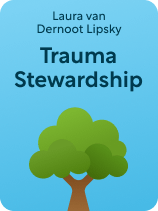

This article is an excerpt from the Shortform book guide to "Trauma Stewardship" by Laura van Dernoot Lipsky. Shortform has the world's best summaries and analyses of books you should be reading.
Like this article? Sign up for a free trial here.
What is the Trauma Stewardship book by Laura van Dernoot Lipsky about? What are the negative impacts of caring for trauma patients?
In Trauma Stewardship, Laura van Dernoot Lipsky discusses the warning signs of secondary trauma that caregivers may experience. By replenishing your energy for healthy caregiving, you can cope with the trauma that you witness.
Read below for an overview of Trauma Stewardship.
Trauma Stewardship by Laura van Dernoot Lipsky
In the Trauma Stewardship book, Laura van Dernoot Lipsky provides a guide on how to care for others who have gone through trauma by learning to care for ourselves—a practice she calls trauma stewardship. Trauma, loss, and suffering are unfortunate, everyday realities: Disadvantaged people struggle to meet basic living needs, natural disasters damage homes, and habitat loss threatens the survival of endangered species. While the effects of trauma are damaging to those who directly suffer from it, there’s another group at risk: the caregivers who witness and tend to the trauma of others.
Lipsky argues that to be fully present and emotionally available to people who are suffering, we must acknowledge and address the impact that secondary trauma (the harm we experience when exposed to others’ trauma) has on us and our ability to help others. Lipsky’s trauma stewardship framework covers how to manage secondary trauma and support yourself so you can support others to your fullest capacity.
What Are Trauma Stewardship and Secondary Trauma?
According to Lipsky, practicing trauma stewardship means tending to your own needs and emotions so that you can fully and compassionately help others who are suffering. To practice trauma stewardship, we must recognize that trauma takes a mental, physical, and emotional toll on caregivers. Lipsky refers to this toll as your trauma exposure response, also known as secondary trauma. When you’re regularly involved with traumatic experiences, the stress and negative emotions can begin to wear on you.
If you lack a proper way to cope, secondary trauma can damage your worldview, quality of life, ability to care for others, and health. Secondary trauma can also lead you to develop emotional defense mechanisms that block your ability to empathize with and care for others. Therefore, to remain healthy, self-care is crucial for anyone who’s immersed in environments of loss, hardship, and pain—healthcare workers, animal rights activists, military personnel, people caring for ill family members, and environmentalists, to name a few.
Many people who work with trauma have the opportunity to dramatically improve or worsen someone’s life. Lipsky argues that with so much on the line, you must find a healthy middle ground between numbing yourself to other people’s pain and letting it overwhelm you in order to be an effective caregiver. Addressing the effects of secondary trauma allows you to truly be present for others not just physically, but emotionally.
Signs of Secondary Trauma
According to Lipsky, people have different responses to trauma exposure, and you must first understand how secondary trauma affects you so you can better care for others. Let’s look at eight signs that you may be experiencing secondary trauma.
Sign #1: Feeling Like Your Actions Don’t Matter
Lipsky explains that many people regularly exposed to other people’s trauma develop a sense of helplessness. A major difficulty when working with trauma sufferers is that the source that causes the trauma rarely goes away. The magnitude of colossal crises such as homelessness or the threat of extinction can feel impossible to combat as an individual and causes people to feel overwhelmed. Thus, carers may feel like they’re unable to make a real difference and think that their efforts are never enough.
Sign #2: Feeling Angry or Fearful
Lipsky writes that witnessing the trauma of others can cause you to build up feelings of anger and fear. She explains that these feelings are natural but that most of us haven’t been taught proper ways to process them. As a result, we often try to suppress them rather than address them—for example, by responding with cynical humor that helps us avoid our feelings rather than understand and work through them.
Fear and anger limit our ability to navigate and approach trauma with nuance and sensitivity because they influence our actions. When we allow fear and anger to continue influencing how we approach new situations, we risk taking those emotions out on others—for example, rather than take productive measures to help others, we might always look for someone to blame or withdraw from situations that make us feel vulnerable.
Sign #3: Feeling Guilty
According to Lipsky, another common sign of secondary trauma is feeling guilty about enjoying your life. If you’re frequently surrounded by people experiencing hardship, you might feel guilty about the good things in your life because you’re aware that many others are suffering. Lipsky writes that this guilt is a sign that you’ve blurred the lines between yourself and others, which can make it harder for you to enjoy the people, things, and experiences you’d otherwise derive happiness from.
Sign #4: Feeling Constant Exhaustion
According to Lipsky, another sign that you may be experiencing secondary trauma is that your physical, emotional, and mental reserves are always drained. In fact, many have the misconception that putting in good work means that you should be exhausted at the day’s end. Often, this belief causes people to accept unreasonable workloads or responsibilities. However, Lipsky argues that this self-sacrificial way of thinking makes it harder to provide quality care. When you push yourself past your limits, the quality of your work decreases as you lack the energy to navigate traumatic environments with sensitivity and care.
Sign #5: Struggling to Detach From Work
Lipsky states that people who work regularly with trauma sufferers often find it hard to leave work when the day is done. The cause and the people you’re helping feel too important to detach for even a minute. However, when you become overly focused on your job, Lipsky explains, you neglect the aspects of your life that are equally important, such as your relationships and your health. Let’s look at four ways work can become all-consuming.
- You become hypervigilant of danger: People experiencing secondary trauma often remain in a hyper-alert state to try to anticipate threats and prevent anything bad from happening.
- You experience moments of dissociation: You regularly tune out of the present moment and lose track of what you’re doing because you’re recalling a traumatic event.
- Work becomes your source of self-worth: You become obsessed with your work because helping others and making a difference makes you feel like you’re important.
- You avoid everything: When work becomes so draining, some people grow to dread it and try to avoid it entirely. You might wish an excuse would come up so you don’t have to show up to work. Lipsky argues that avoidance can become a habit: You might feel like your personal life is just as draining as your work and start to isolate yourself from family, friends, and positive activities.
Sign #6: Struggling to See Nuance
Lipsky writes that trauma exposure can cause people to view people and situations in simplistic ways and develop polarized opinions. When trauma work leaves you drained mentally and physically, you lack the capacity to consider things deeply and from different perspectives. This might lead you to see things only in black-and-white or label things and people as “good” or “bad.” Lipsky explains that while some trauma sufferers adopt this generalized way of thinking to feel a sense of certainty and security about themselves and their environment, this way of thinking can prevent you, as a caregiver, from navigating situations with sensitivity and without judgment.
Beyond diminishing your capacity for complex thought, secondary trauma reduces your ability to think creatively, which in turn impacts your ability to come up with innovative solutions and make good decisions. According to Lipsky, this is because you can only be creative and entertain many possible options when you’re relaxed. However, the more you get wound up in the trauma of others, the harder it is to relax.
Sign #7: Struggling to Be Compassionate
According to Lipsky, people who regularly work with suffering and loss become desensitized to it. They no longer feel emotionally moved by the pain experienced by others. This desensitization makes it harder for them to be compassionate listeners. Instead of listening with an open mind, they might compare the hardships of different people and minimize those that are less severe. This subconscious act prevents them from giving the same compassion and attention to all people in need of support.
Sign #8: Struggling With Addiction
Lipsky explains that many people experiencing secondary trauma also struggle with addictions. She elaborates that trauma workers often turn to drinking alcohol, playing video games, or overworking themselves to avoid coping with difficult feelings they’ve developed from their trauma work. These distractions, however, are only temporary and, over time, deplete their ability to cope with emotions and be present when helping others.
Practice Self-Care to Practice Trauma Stewardship (secondary trauma treatment)
Now that we’ve discussed the signs of secondary trauma, let’s discuss how you can practice trauma stewardship to manage this type of trauma. To be more reliable, accessible, and effective for the people, animals, or environment that you’re tending to, Lipsky says you must practice self-reflection and self-care. Since secondary trauma results from you internalizing or “taking on” the pain of others, you must focus on healing yourself from within—by addressing your own needs, feelings, and intentions with mindfulness.
Lipsky provides five strategies for practicing self-care to be a better trauma steward:
Strategy #1: Make Time for Reflection
According to Lipsky, the first step of embracing a more mindful approach to trauma care is to regularly reflect on your needs, motivations, and emotions. You can do this by setting aside a small window of time in the morning for reflection. You can also practice meditation and breathing exercises.
Lipsky explains that understanding ourselves is key to processing the effects that secondary trauma has on us. Often, we get so caught up in our daily routines and work stresses that we lose connection to our personal needs and the reasons why we wanted to help others in the first place. This can cause us to feel like we have no control or options in our lives when we really do.
When you practice reflection, ask yourself: “What is my reason for doing what I’m doing?” This question helps you realize that trauma doesn’t control you and that you have a choice in what to focus on when working with trauma. Lipsky recommends you discuss your reasons with people you trust or write them down as a reminder for the future. As you reflect on your reasons, consider whether continuing in your current work is good for your health. It’s possible that the work you do may no longer be in your best interest if it’s negatively impacting your well-being.
One reason many people engage in trauma work, Lipsky explains, is a desire for trauma mastery—a coping mechanism to recapture a sense of control that they didn’t have during a past traumatic experience. For example, you might work in the medical field if you had lost a loved one to illness when you were younger.
If trauma mastery is part of the reason you pursue your line of work, Lipsky advises that you seek support and healing for your original trauma so you don’t use your work as the main way to cope with your trauma. People with personal stakes tied to their work, she argues, might put an unhealthy amount of pressure on themselves. One way you can better understand how to manage your desire for trauma mastery while working with the trauma of others is by studying how others have dealt with their personal trauma while involved in trauma work.
Strategy #2: Focus on the Positives
When exposed to trauma, you might feel overwhelmed by how bad situations seem and how little control you have over them. However, Lipsky argues that you can restore your sense of agency by deliberately choosing to focus on the positives rather than negatives—on what you can do instead of what you can’t. This practice reminds you that you have a choice in every moment and allows you to reframe situations in healthier ways and take productive action. When you regularly choose to focus on positive things, it becomes easier to notice the positives. Lipsky cautions, though, that reframing situations to see their upsides doesn’t mean suppressing your negative emotions.
To take control of your focus, Lipsky offers a few suggestions:
Focus on your resources. When you feel overwhelmed or distressed, think about the sources of support and comfort you have in your life—the memories you’ve had, the people you know, or the places you’ve visited that you associate with peace and calm. For example, you might imagine your favorite reading nook or your pet. When you direct your awareness to your resources, you draw your attention away from what’s distressing you. This allows you to snap yourself out of your panic and calm your nervous system.
Make a Plan B. Create an alternative vision of your life, whether it involves a shift in your career, a move to a different location, or an entirely new lifestyle. When you consider alternative options, you recognize that you have a life outside of your work and that you always have the freedom to choose how you want to live it.
Strategy #3: Find a Supportive Community
According to Lipsky, a supportive community can help you rebuild your ability to be compassionate toward yourself and others. This community could be the members of your gardening club, your group of gaming friends, or your hiking partners—all that matters is that they support your growth and encourage you to be a better person.
A community helps you restore your compassion because its members validate your feelings and help you navigate your unhealthy habits. When others are nonjudgmental and supportive toward you, you begin to view your own feelings and struggles in the same light. This self-compassion, in turn, makes you more able to understand people you both agree and disagree with and treat them without judgment or malice. This compassionate approach, she argues, is necessary when working with people in pain or crisis.
Strategy #4: Create a Healthy Work-Life Balance
While laboring until complete exhaustion and dedicating every second of time to your cause might feel like the best way to make a difference, Lipsky argues that this is not the case. To properly care for others, she argues, you must take a healthier approach to your work—one in which you give yourself time and space to rest and renew.
Lipsky offers several tips for how to create a healthier work-life balance:
Encourage healthier work habits. Reflect on whether your work schedule is reasonable and consider how you can better care for the well-being of you and your coworkers. For example, make commitments with your coworkers to take breaks for lunch instead of eating in front of your computers.
Take your mind off work. Reflect on your daily routine and identify times when you can disengage from work and check in with your needs and feelings—for example, while you’re boiling a cup of tea. Additionally, build up your life outside of work by engaging in new hobbies, interacting with supportive people, and making a conscious effort not to check your devices. By taking time to recharge your physical and emotional batteries, you’ll be more effective when you’re at work.
Practice gratitude. Even during routine tasks like microwaving a meal, recognize opportunities to express your gratitude. Negative emotions like irritation and disappointment are natural when you’re exposed to suffering. While valid, harboring these emotions can harm your well-being and hinder your work. By practicing more gratitude, you can increase your resilience and make work feel more fulfilling rather than draining.
Process your pain and emotions. To approach your work in a healthier way, acknowledge and find a way to process your negative emotions. Lipsky explains that people who do trauma work often absorb the pain and suffering of others. However, if you hold on to these feelings, your mental, emotional, and physical health will suffer. To process your emotions, Lipsky recommends you practice mindful activities—ones in which you’re focused on the present moment—such as meditation, physical exercise, creative hobbies, or going out into nature. When you practice mindful activities, you allow yourself space to think about, acknowledge, and release negative energy instead of letting them build up inside you.
Strategy #5: Create a Daily Practice
To engage in sustainable and fulfilling trauma work in the long term, make mindfulness a daily habit and regularly practice the four strategies for self-care. According to Lipsky, the more you connect with yourself, the more aware you become of your resources and autonomy, and the more motivation you have to do the work that you do.
To make mindful self-care a regular practice, Lipsky offers two suggestions:
Set a daily goal. At the start of each day, identify a small goal you want to accomplish, such as eating healthier snack options or practicing more conscious breathing. According to Lipsky, identifying a daily goal gives you a sense of control, reminding you that the stress or the situations you encounter at work don’t determine your day—you do.
Set mindfulness reminders. Consider setting alarms on your phone, scheduling small parts of your day, or creating specific triggers to be mindful (like every time you enter a new location). Lipsky explains that being present in our daily activities can be difficult to achieve—urgent deadlines might make us irritated at a slower team member or you might be distracted by an upcoming social outing with friends. By setting reminders, you can be mindful more regularly, which allows you to think and approach your work with intentionality and control.

———End of Preview———
Like what you just read? Read the rest of the world's best book summary and analysis of Laura van Dernoot Lipsky's "Trauma Stewardship" at Shortform.
Here's what you'll find in our full Trauma Stewardship summary:
- That the best way to care for others is to care for yourself
- How trauma damages the caregivers who are exposed to others' trauma
- How caregivers can manage secondary trauma to better support others






